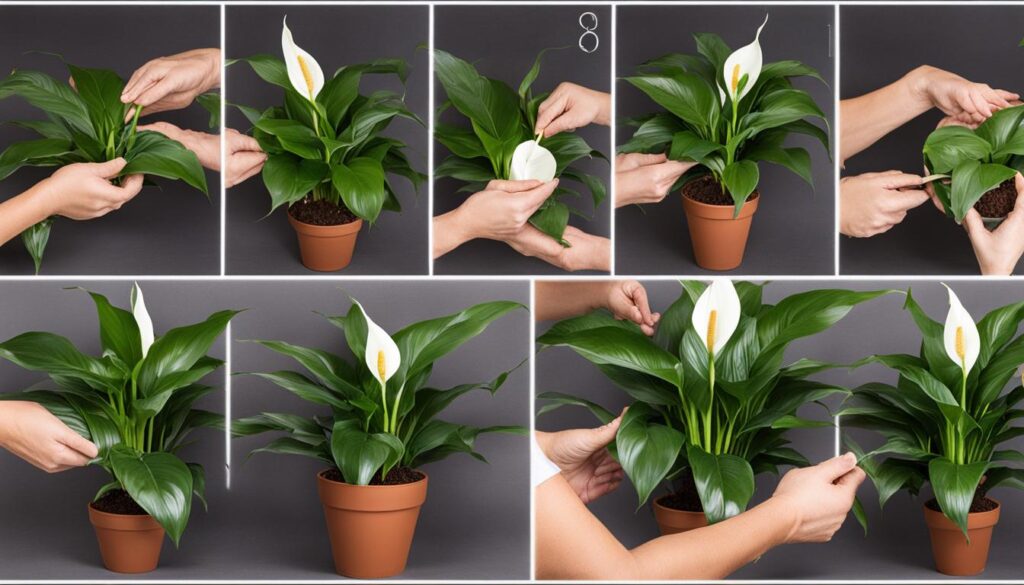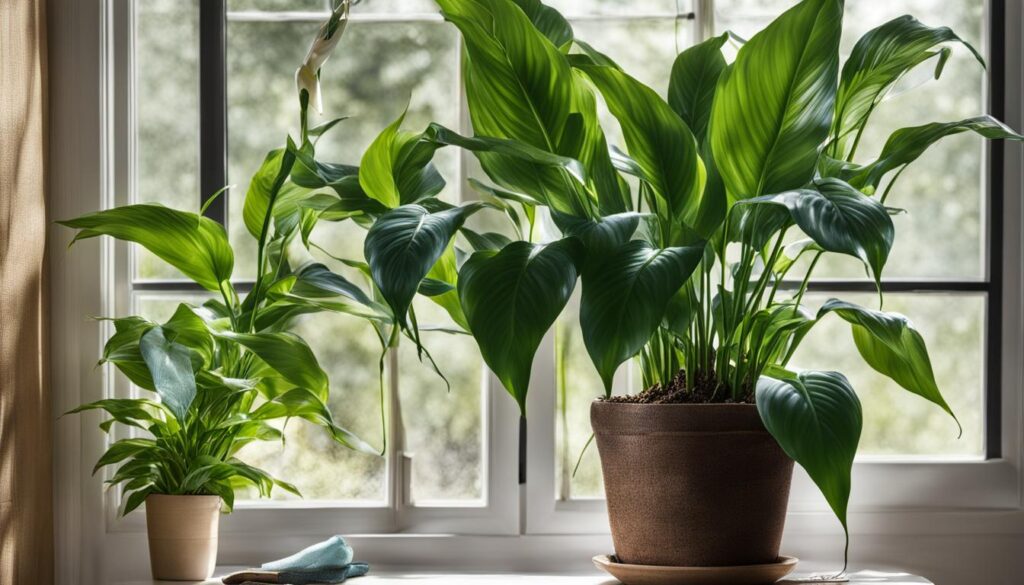Peace Lily Grow and Care guide, Types, Pruning, Light, Water, Soil, Temperature, Fertilize, Pests and disease treatment
Peace lilies are beautiful and popular houseplants that can add a touch of elegance to any indoor space. These tropical, evergreen plants belong to the Arum family and come in various types, including Spathiphyllum wallisii, ‘Petite’, ‘Sensation’, ‘Domino’, and ‘Mojo Lime’. While they can grow up to 6 feet tall outdoors, indoor peace lilies typically reach a height of 16 inches. It’s important to note that peace lilies are not cold-hardy and are best suited for warm, humid climates.
When it comes to caring for peace lilies, there are a few key factors to consider. Providing them with the right amount of light, water, and soil, as well as maintaining appropriate temperature levels and addressing potential pests, will ensure their health and vitality. In this article, I will guide you through the various aspects of peace lily care, including pruning, lighting requirements, watering guidelines, soil and fertilizing tips, common pests and diseases, and some useful care tips and tricks.
You can also read Top 20 of the Beautiful Flower Plants for Autumn

Key Takeaways:
- Peace lilies are tropical, evergreen plants that come in various types.
- Indoor peace lilies typically reach a height of 16 inches.
- They require dappled sunlight and consistent moisture to thrive.
- The soil should be well-draining, and fertilizing should be done occasionally with a balanced houseplant fertilizer.
- Common pests that may affect peace lilies include scale and mealybugs.
- It prefers a range between 65°F (19°C) and 75°F (24°C) during the day and slightly cooler temperatures at night.
How to Care for Peace Lilies
If you’re looking to add a touch of elegance to your indoor space, peace lilies are an excellent choice. Not only are they beautiful, but they also require minimal care. In this section, I will guide you on how to care for peace lilies, from providing the right amount of light and water to maintaining the ideal temperature and humidity.
Light Requirements
Peace lilies thrive in dappled sunlight. While they can tolerate low light conditions, it’s best to place them in an east-facing window or an area that receives bright, indirect light. Direct sunlight should be avoided as it can scorch the leaves. If you notice that your peace lily is not flowering, try moving it to a brighter location for a few hours each day.
Watering and Humidity
Keeping the soil lightly moist is crucial for the health of peace lilies. Water the plant when the top inch of soil feels dry to the touch. However, be careful not to overwater as soggy soil can lead to root rot or you can also do bottom watering to the plant. To help maintain the high humidity levels that these tropical plants love, you can mist the leaves or place their pot on a tray filled with moistened gravel. This will create a humid microclimate around the plant.
Fertilizing and Temperature
Peace lilies are not heavy feeders and only require occasional fertilization. Use a balanced houseplant fertilizer and apply it at quarter strength to avoid burning the roots. During the growing season (spring and summer), fertilize every two to four weeks. Regarding temperature, peace lilies prefer a range between 65°F (19°C) and 75°F (24°C) during the day and slightly cooler temperatures at night.
By following these care tips, you can ensure that your peace lilies thrive and bring beauty and tranquility to your home or office space. Keep in mind that each plant is unique, so it’s essential to monitor their specific needs and adjust your care routine accordingly.
You can also read Best 11 Tips for Beginners to Start Gardening
How to Growing the Plant and Repot Peace Lilies
Growing and repotting peace lilies is essential to ensure their proper growth and vitality. Here are the steps to follow:
- Choose a well-draining container: Peace lilies prefer containers with drainage holes to prevent waterlogging. The container should be slightly larger than the root ball of the plant.
- Prepare the potting soil: Use all-purpose potting soil that retains moisture but drains well. Avoid using heavy garden soil as it can cause root rot.
- Planting: Place the peace lily in the center of the container, ensuring that the crown of the plant sits slightly above the soil level. Fill the gaps around the roots with potting soil, gently firming it down.
- Watering: Water the plant thoroughly after planting to help settle the soil, ensuring that the excess water drains away.
- Placement: Find a suitable location for your peace lily. They thrive in bright, indirect light but can tolerate low-light conditions. Avoid placing them in direct sunlight as it can damage the leaves.
- Repotting: Repotting should be done every few years or when the plant becomes root-bound. Choose a slightly larger container and follow the same planting process as above.
- Dividing: If you wish to propagate your peace lily or create more plants, you can divide the clumps during repotting. Carefully separate the rhizomes, ensuring each division has several leaves.
By following these guidelines, you can ensure that your peace lilies have a healthy start and continue to thrive in their new homes.

Comparison of Planting and Repotting Peace Lilies
| Aspect | Planting | Repotting |
|---|---|---|
| Container | Choose a well-draining container slightly larger than the root ball. | Opt for a slightly larger container when the plant becomes root-bound. |
| Potting Soil | Use all-purpose potting soil that drains well. | Same as planting, replacing the soil with fresh potting mix. |
| Watering | Thoroughly water the plant after planting. | Water the plant after repotting to help settle the soil. |
| Placement | Find a bright location with indirect light. | Same as planting, choosing a suitable location for the repotted plant. |
| Dividing | N/A | During repotting, divide the clumps by separating the rhizomes. |
Peace Lily Lighting Requirements
When it comes to lighting, peace lilies thrive in bright, indirect sunlight. It’s best to place them near east-facing windows or north-facing windows where they can receive the right amount of light without being exposed to harsh direct sunlight. Direct sunlight can damage the plant and cause it to dry out.
While peace lilies can tolerate low light conditions, it’s important to note that they may produce fewer flowers in such environments. To encourage optimal growth and flowering, it’s recommended to provide them with bright, indirect light for at least a few hours each day. This can be achieved by moving the plant to a brighter spot during the day or by using artificial grow lights, especially in spaces with limited natural light.
“Peace lilies thrive in bright, indirect sunlight. For optimal growth and flowering, provide them with bright, indirect light for a few hours each day.”
Remember, finding the right balance is key. While peace lilies enjoy bright light, it’s essential to avoid direct sunlight to prevent any harm to the plant. By providing them with the ideal lighting conditions, you can ensure that your peace lily remains healthy and flourishing.
| Lighting Conditions | Effect on Peace Lilies |
|---|---|
| Bright, indirect sunlight | Optimal growth and flowering |
| Low light conditions | Possible decrease in flower production |
| Direct sunlight | Potential damage and drying out of the plant |
Peace Lily Watering Guidelines
Proper watering is essential for the health and well-being of peace lilies. The frequency of watering depends on the dryness of the soil rather than a set schedule. When the top inch of the soil feels dry to the touch, it’s time to water the plant. Avoid overwatering, as peace lilies are susceptible to root rot. Allow the soil to drain completely after watering to prevent waterlogged conditions.
One helpful tip is to observe the plant’s leaves. When the leaves start to droop, it is a clear indication that watering is needed. However, it’s important not to wait until the plant reaches this point. Regularly checking the soil moisture level is key to maintaining a healthy water balance for your peace lily.
It’s worth noting that peace lilies are sensitive to chemicals commonly found in tap water, such as chlorine and fluoride. Using filtered, room-temperature water is preferred to maintain the plant’s overall health and vitality. This helps to prevent the accumulation of harmful chemicals that can damage the roots and inhibit proper growth. If filtered water is not readily available, allowing tap water to sit overnight before using it to water your peace lily can help dissipate some of the chlorine.
Peace Lily Watering Guidelines
| Watering Guidelines | Benefits | Drawbacks |
|---|---|---|
| Water when top inch of soil is dry | Prevents overwatering and root rot | Underwatering can lead to dehydration |
| Use filtered, room-temperature water | Avoids harmful chemicals in tap water | Filtered water may not always be readily available |
| Allow water to drain completely | Prevents waterlogged conditions | Insufficient drainage can lead to root rot |
By following these guidelines and providing your peace lily with the right amount of water, you can ensure its optimal growth and longevity. Remember to observe the plant closely, adjust the watering frequency as needed, and use filtered water whenever possible. With proper watering, your peace lily will thrive and bring beauty to your indoor space.
Peace Lily Soil and Fertilizing Tips
When it comes to the soil and fertilizing needs of peace lilies, there are a few key considerations to keep in mind. Peace lilies require well-draining, all-purpose potting soil that allows for proper root aeration. This type of soil helps prevent waterlogging and root rot, which can be detrimental to the health of the plant. Additionally, peace lilies prefer a soil mix that can retain moisture but still dries out slowly over time. This balance ensures that the plant’s roots have access to adequate water without becoming oversaturated.
As for fertilizing, peace lilies are not heavy feeders and should be fertilized occasionally with a balanced houseplant fertilizer. It is best to use a fertilizer specifically formulated for indoor plants and follow the package instructions for application rates. During the spring and summer growing seasons, when peace lilies are actively growing, a regular fertilizing schedule can help promote healthy foliage and vibrant blooms. However, it is important to avoid overfertilizing, as this can lead to burning of the leaf tips. It is recommended to use the fertilizer at a quarter of the recommended strength to prevent any potential damage to the plant.
To summarize, peace lilies thrive in well-draining, all-purpose potting soil that allows for proper root aeration and moisture retention. They should be fertilized occasionally with a balanced houseplant fertilizer, following the package instructions for application rates. Maintaining this soil and fertilizing balance will help ensure the health and vitality of your peace lily.
| Soil Needs: | Fertilizing Tips: |
|---|---|
| Well-draining, all-purpose potting soil | Use a balanced houseplant fertilizer or organic fertiliser |
| Soil that retains moisture but dries out slowly | Follow package instructions for application rates |
| Avoid waterlogging and root rot | Use fertilizer at a quarter of the recommended strength |
Common Peace Lily Pests and Diseases
While peace lilies are generally resistant to pests and diseases, there are a few common issues that can arise. Recognizing and addressing these problems promptly is key to keeping your peace lily healthy and thriving.
Pest Infestations
Two pests that can affect peace lilies are scale and mealybugs. Scale insects appear as small bumps on the leaves and stems, while mealybugs are tiny, white, cotton-like insects that cluster together. Both pests feed on the plant’s sap, leading to yellowing leaves, stunted growth, and overall decline.
To control these pests, wipe the leaves with a solution of dish soap and water or use insecticidal soap. Ensure complete coverage of all affected areas, as these pests can be resilient. Regular monitoring and early treatment can help prevent severe infestations.
Common Diseases
Peace lilies can also experience a few common diseases, although they are generally less susceptible compared to other houseplants. However, it’s still important to be vigilant and address any issues promptly.
- Root rot: Overwatering or poor drainage can cause root rot in peace lilies. To prevent this, ensure that your plant’s pot has drainage holes and that you allow the soil to dry out slightly between waterings.
- Leaf spot: Leaf spot is characterized by brown or black spots on the leaves. This fungal disease can be caused by overwatering, poor air circulation, or high humidity. Remove affected leaves and ensure proper watering and ventilation to minimize the risk of leaf spots.
By monitoring your peace lily for signs of pests and diseases and taking appropriate action, you can help keep your plant healthy and vibrant.
| Pests | Diseases |
|---|---|
| Scale insects | Root rot |
| Mealybugs | Leaf spot |
Peace Lily Care Tips and Tricks
When it comes to caring for peace lilies, there are a few tips and tricks that can help you ensure the health and beauty of these tropical plants. Regular dusting of the large leaves can aid in proper photosynthesis, allowing the plant to thrive. To encourage flowering, consider placing your peace lily in a brighter location with bright, indirect light for a few hours each day. This will provide the necessary energy for the plant to produce vibrant blooms.
If your peace lily is not blooming as expected, it may be a sign of a common issue that can be easily addressed. Green flowers or weak-looking blooms may indicate that the plant needs a little extra nutrition. Try adjusting your fertilization routine by cutting back on fertilizing or switching to a fertilizer specifically formulated for flowering plants. This can often provide the boost your peace lily needs to produce stunning flowers.

Conclusion
In conclusion, peace lilies are versatile and popular houseplants that can thrive in the unique climate of the United Kingdom. With proper care and attention, they can bring beauty and elegance to any indoor space. By following the guidelines for lighting, watering, soil, temperature, and fertilizing, peace lilies can flourish and add a touch of nature to your home or office.
Regular pruning can help maintain the shape and health of the plant, while also removing any damaged or yellowing leaves. Consistent care and attention to watering and humidity levels can help prevent common issues such as brown leaf tips and yellow leaves.
Remember, peace lilies are tropical plants that require dappled sunlight, consistent moisture, and high humidity. By providing the right conditions and occasional fertilization, you can enjoy the beauty of peace lilies all year round. So go ahead and bring some greenery into your life with these lovely, low-maintenance houseplants.
FAQ
What types of peace lilies are there?
Peace lilies come in various types, including Spathiphyllum wallisii, ‘Petite’, ‘Sensation’, ‘Domino’, and ‘Mojo Lime’.
How do I prune a peace lily?
To prune a peace lily, simply remove any damaged or yellowing leaves with clean scissors or shears.
What kind of light does a peace lily need?
Peace lilies require dappled sunlight and should be placed in indirect but bright sunlight, such as an east-facing window.
How often should I water my peace lily?
Water your peace lily when the soil feels dry to the touch. The frequency of watering depends on the dryness of the soil rather than a set schedule.
What kind of soil should I use for my peace lily?
Peace lilies require well-draining, all-purpose potting soil.
What is the ideal temperature for a peace lily?
Peace lilies prefer temperatures between 65°F and 75°F during the day and slightly cooler at night.
How often should I fertilize my peace lily?
Peace lilies are not heavy feeders and should be fertilized occasionally with a balanced houseplant fertilizer, especially during the spring and summer growing season.
What pests are common for peace lilies?
Peace lilies are generally resistant to pests, but they can be susceptible to scale and mealybugs.
Any tips for caring for peace lilies?
Regularly dusting the leaves and placing the plant in a brighter location with indirect light can aid in proper photosynthesis and encourage flowering.
What should I do if peace lily is not flowering?
If you notice that your peace lily is not flowering, try moving it to a brighter location for a few hours each day.




